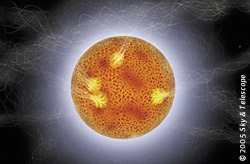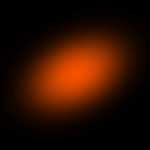
This illustration, which is based on the latest scientific thinking, represents how a magnetar might appear if we could view it up close with X-ray vision. But this is not something anyone would want to do. Magnetars are neutron stars with magnetic fields so powerful that they could kill a person from 1,000 kilometers away by warping the atoms in living flesh. Magnetars can also unleash powerful flares that could kill at much larger distances.
S&T: Gregg Dinderman.
On December 27, 2004, more than a dozen spacecraft recorded the brightest event from outside the solar system ever observed in the history of astronomy. The spacecraft, which included Earth-orbiting satellites as well as interplanetary probes such as Cassini, Mars Odyssey, and Ulysses, picked up a powerful burst of gamma rays and X-rays from one of the most exotic beasts in the galactic zoo: a magnetar. These bizarre objects are neutron stars possessing magnetic fields a million billion times more powerful than Earth's field, or some 1,000 times greater that those of normal neutron stars.
The "superflare," from a magnetar named SGR 1806–20, irradiated Earth with more total energy than a powerful solar flare. Yet this object is an estimated 50,000 light-years away in Sagittarius, on the far side of the Milky Way galaxy behind dense interstellar clouds. "This is mind-boggling when you think about how far away it is," says Kevin C. Hurley (University of California, Berkeley), one of the lead investigators.
Bryan M. Gaensler (Harvard-Smithsonian Center for Astrophysics), who conducted radio observations of the superflare's afterglow, notes that only the Sun and perhaps a handful of spectacular comets have doused Earth with more total energy than SGR 1806–20's superflare during the two-tenths of a second that it peaked in intensity. During that flicker of time it outshone the full Moon by a factor of two. The magnetar must have let loose as much energy as the Sun generates in 250,000 years, assuming that the distance estimate is accurate.

NASA's RHESSI satellite, which was designed to observe solar flares, captured this light curve of the superflare at X-ray energies of 20,000 to 50,000 electron volts. It shows the remarkable initial spike of energy (note the logarithmic scale on the vertical axis) followed by a tail that pulsed strongly every 7.56 seconds, the magnetar's rotation period.
Source: Steve Boggs / RHESSI Team / NASA / UC Berkeley.
The burst was so powerful that some of its gamma rays and X-rays reflected off the Moon (a very poor mirror) and were detected by the Russian Helicon-Coronas-F satellite. Amateur radio solar observers with the American Association of Variable Star Observers easily detected the superflare's ionizing effects on Earth's upper atmosphere, even though the radiation smacked into our planet's daylight hemisphere and thus had to compete with the Sun.
The superflare has generated intense observational and theoretical research around the world, as the astronomical community has been forced to confront the question of how such a tiny object, about 20 kilometers (12 miles) across, could unleash such unmitigated fury.
Although the details remain shrouded in mystery, the energy almost certainly resulted from SGR 1806–20 shedding part of its extraordinary magnetic field. Magnetars, in fact, have the strongest magnetic fields in the universe. Four magnetars, including this one, are known as soft gamma repeaters, or SGRs, because they occasionally release powerful flares of low-energy (soft) gamma rays. But the December 27th event was roughly 100 times more powerful than any previously observed SGR flare.
Magnetic field lines weaving through the star probably flex its solid crust and heat its interior, leading to stress that is occasionally relieved in sudden "starquakes." Such an event allows the magnetic field to jerk pieces of the crust around and rearrange itself to a lower-energy state. This rearrangement, which is a vastly scaled-up version of a solar flare (a "reconnection event" in the magnetic field), releases a huge amount of magnetic energy in the form of gamma rays, electrons, and positrons (the antimatter counterpart of electrons). It's this radiation that was responsible for the initial spike, which contained 99.7 percent of the superflare's total energy.
Electrons and positrons confined by the magnetar's magnetic field annihilate one another over the next several minutes, accounting for a fading tail of emission after the initial 0.2-second spike. This "trapped fireball" model was developed in the mid-1990s by Robert C. Duncan (University of Texas, Austin) and Christopher Thompson (Canadian Institute of Theoretical Astrophysics), who also predicted the existence of magnetars in 1992.

This image, which is a model based on radio observations from the Very Large Array, shows the fading afterglow of SGR 1806–20's superflare. This afterglow gives astronomers a more detailed view of the more distant and energetic afterglows arising from gamma-ray bursts.
Courtesy NRAO / CfA / Bryan Gaensler.
The SGR superflare might partially explain a long-standing mystery surrounding gamma-ray bursts (GRBs). These mega-powerful explosions fall into two distinct classes: long events lasting several seconds to several minutes, and short bursts, which last no more than two seconds.
If one took SGR 1806–20 and moved it to another galaxy, the superflare would mimic a short gamma-ray burst (GRB). Previous generations of satellites would have detected the initial 0.2-second spike, but they would not have been sensitive enough to detect the fading tail. Astronomers have long suspected that that the short bursts are triggered by the merging of two neutron stars or a neutron star and a black hole. But as Duncan points out, "These theories remain speculative. We've seen that SGRs can produce short GRBs." NASA's recently launched Swift satellite could detect an event like SGR 1806–20's out to about 100 million light-years, which future observations should enable astronomers to determine what fraction of short GRBs are caused by SGR superflares.
Thanks to the magnetar's great distance, the superflare posed no threat to humanity or Earth's biosphere. The International Space Station was on the opposite side of Earth when the flare hit our planet, but even if the astronauts had faced the full fury of the blast, they would have received a radiation dose less than a dental X-ray. An SGR superflare's pulse of high-energy radiation could seriously damage a planet's atmosphere only if it occurred within about 6 light-years, according to Adrian L. Melott (University of Kansas).

AAVSO solar observer Paul Campbell of Edmonton, Alberta, recorded this sudden disturbance in Earth's upper atmosphere (the ionosphere) at the very moment that the burst of high-energy radiation from SGR 1806–20 hit our planet on December 27, 2004. Campbell's homemade antenna and receiver setup was monitoring the 24.8-kilohertz radio signal from the US Navy's 250-kilowatt transmitter in Jim Creek, Washington, when it recorded a sharp increase in the signal's strength.
Courtesy Paul Campbell / AAVSO.
Numerous papers about the event have already appeared on the preprint server Astro-ph. A number of other papers, including theoretical research that might explain the outburst, are currently being peer-reviewed prior to publication in professional journals. Because of embargoes imposed by some of these journals, astronomers have not been allowed to communicate their results to other scientists, which has hindered progress in understanding this event so far. More details about the superflare, including amateur observations of the atmospheric disturbance, will appear in the May Sky & Telescope.
 0
0
Comments
You must be logged in to post a comment.